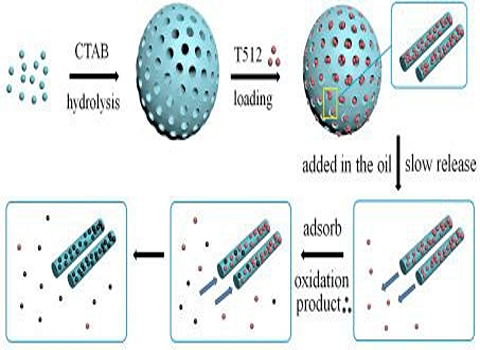Silica-Coated Nanocomposites of Magnetic Nanoparticles and Quantum Dots: Pioneering the Future of Materials Science
In the realm of materials science, silica-coated nanocomposites of magnetic nanoparticles and quantum dots have emerged as a powerful and versatile class of materials.
These hybrid structures, combining the unique properties of both magnetic nanoparticles and quantum dots, offer tremendous potential for numerous applications, ranging from biomedicine and electronics to energy and catalysis.
Unleashing the Potential of Silica-Coated Nanocomposites
Silica-coated nanocomposites hold a distinct advantage over their individual components by providing enhanced stability and protection to the nanoparticles and quantum dots.
Silica, a widely used material due to its biocompatibility and low toxicity, acts as a protective shell that prevents agglomeration, degradation, and unwanted reactions.
This coating also allows for easy functionalization with various organic molecules, making these nanocomposites highly customizable and adaptable for specific applications.
One of the primary advantages of silica-coated nanocomposites lies in their magnetic properties, imparted by the embedded magnetic nanoparticles.
Magnetic materials have been widely exploited for applications such as magnetic resonance imaging (MRI), hyperthermia, and drug delivery.
The integration of these magnetic nanoparticles into silica-coated nanocomposites adds the ability to manipulate and control their properties, leading to improved performance and new functionalities.
This allows for targeted drug delivery and selective heating of cancer cells, leading to better therapeutic outcomes.
Additionally, the incorporation of quantum dots within the silica matrix offers a unique and powerful contribution to these nanocomposites.
Quantum dots are semiconductor nanoparticles that exhibit quantum confinement effects, resulting in size-dependent optical and electronic properties.
By integrating quantum dots into the silica shell, the resulting nanocomposites inherit these optical characteristics, enabling applications in areas such as optoelectronics, photovoltaics, and biological labeling.
The silica coating ensures stability and prevents surface degradation of the quantum dots, extending their functionality and lifespan.
Applications for silica-coated nanocomposites
The potential applications of silica-coated nanocomposites are vast.
In the field of electronics, these materials have the potential to revolutionize optoelectronic devices, such as light-emitting diodes (LEDs) and displays, by enhancing their efficiency and color purity.
Their exceptional properties also make them promising candidates for use in solar cells, where their ability to absorb a broad range of wavelengths can boost energy conversion efficiencies.
In the biomedical field, these nanocomposites hold promise as powerful tools for targeted drug delivery and bioimaging.
The magnetic properties enable efficient targeting and controlled release of therapeutic payloads, while the fluorescence properties of quantum dots allow for real-time imaging and tracking of drug delivery vehicles.
Furthermore, the stability and biocompatibility of silica-coated nanocomposites make them increasingly attractive for use in implantable sensors, diagnostic tools, and tissue engineering.
Notably, the synthesis and production of silica-coated nanocomposites have evolved significantly, allowing for large-scale manufacturing.
This has opened up opportunities for commercialization and industrial applications.
Companies in the materials science sector are actively investing in the research, development, and production of these nanocomposites to meet the growing demand in various industries.
Enhancing Biomedicine and Electronics
As the field of nanotechnology continues to advance, the development of silica-coated nanocomposites of magnetic nanoparticles and quantum dots represents a significant milestone.
These materials have the potential to drive innovation and revolutionize multiple sectors, from medicine and electronics to energy and beyond.
The ability to manipulate and harness the unique properties of both magnetic nanoparticles and quantum dots in a controlled and scalable manner opens up the possibilities for exciting new technologies and applications.
The future indeed looks bright for silica-coated nanocomposites, as they play a pivotal role in shaping the world of materials science.
The demand for silica-coated nanocomposites of magnetic nanoparticles and quantum dots is expected to grow exponentially in the coming years, driven by the need for advanced materials that can address complex challenges across various industries.
In the field of energy, these nanocomposites have the potential to revolutionize energy storage and conversion technologies.
By incorporating magnetic nanoparticles and quantum dots, the conductivity and efficiency of batteries and supercapacitors can be significantly improved.
This could lead to longer-lasting and faster-charging batteries for electric vehicles, as well as more efficient and compact energy storage systems for renewable energy sources.
Furthermore, silica-coated nanocomposites hold great promise for catalytic applications.
Due to their unique properties, these materials can act as highly efficient catalysts for various chemical reactions, such as hydrogenation and oxidation.
Their magnetic nature enables easy separation and recycling, making them environmentally friendly alternatives to traditional catalysts.
This opens up new possibilities for sustainable and cost-effective chemical processes in industries such as pharmaceuticals, petrochemicals, and fine chemicals.
In the field of electronics, silica-coated nanocomposites could also have a significant impact on the development of quantum computing.
The integration of magnetic nanoparticles and quantum dots allows for the manipulation and control of quantum states, which are crucial for the operation of quantum computers.
The stability and protection provided by the silica shell ensures the longevity and reliability of these nanocomposites, making them attractive materials for quantum computing applications.
The commercialization of silica-coated nanocomposites is already underway, with several companies and research institutions actively working to bring these materials to market.
As more companies invest in research and development, the cost of production is expected to decrease, making these nanocomposites more accessible for widespread use.
However, challenges still remain in terms of scalability, reproducibility, and optimization of these nanocomposites.
The synthesis process needs to be further refined to ensure consistent quality and performance.
Research efforts are ongoing to fine-tune the properties and functionalities of silica-coated nanocomposites, paving the way for even more advanced applications and improved performance in the future.
In conclusion, silica-coated nanocomposites of magnetic nanoparticles and quantum dots have captured the imagination of scientists and engineers in the field of materials science.
Their unique combination of magnetic and optical properties, along with the stability offered by the silica coating, make them promising candidates for a wide range of applications.
As further research and development continue, the potential for these nanocomposites to revolutionize industries such as biomedicine, electronics, energy, and catalysis becomes increasingly evident.
The future of materials science seems brighter than ever, thanks to the innovative advancements in silica-coated nanocomposites.




